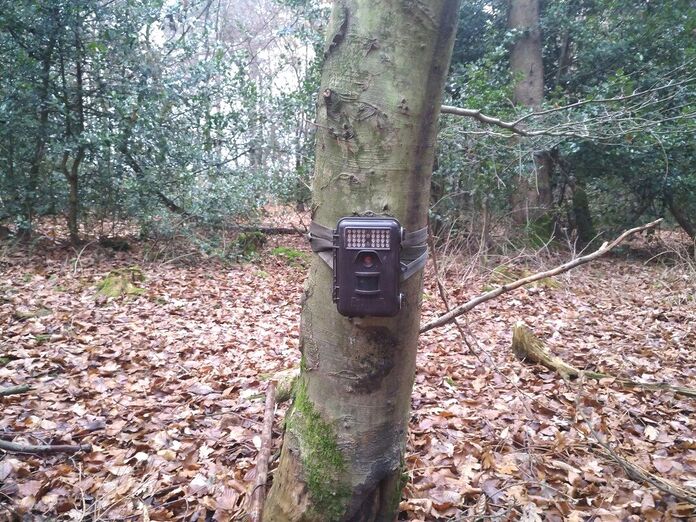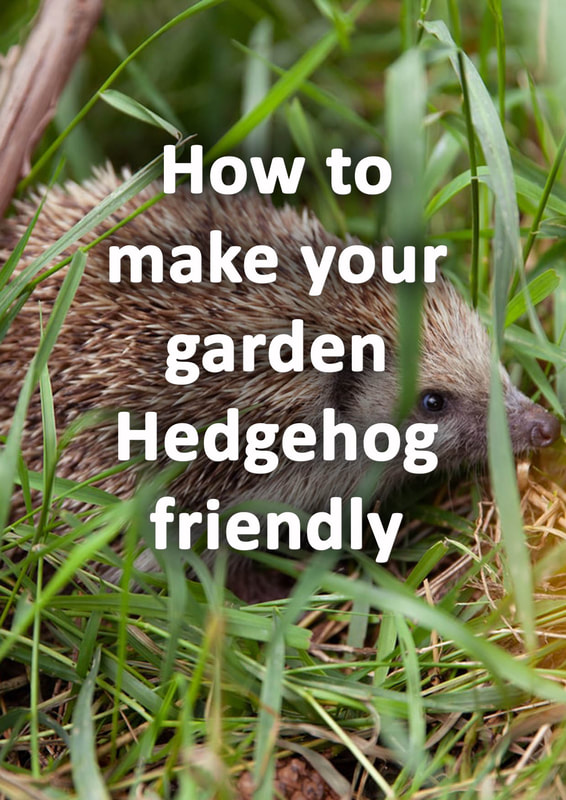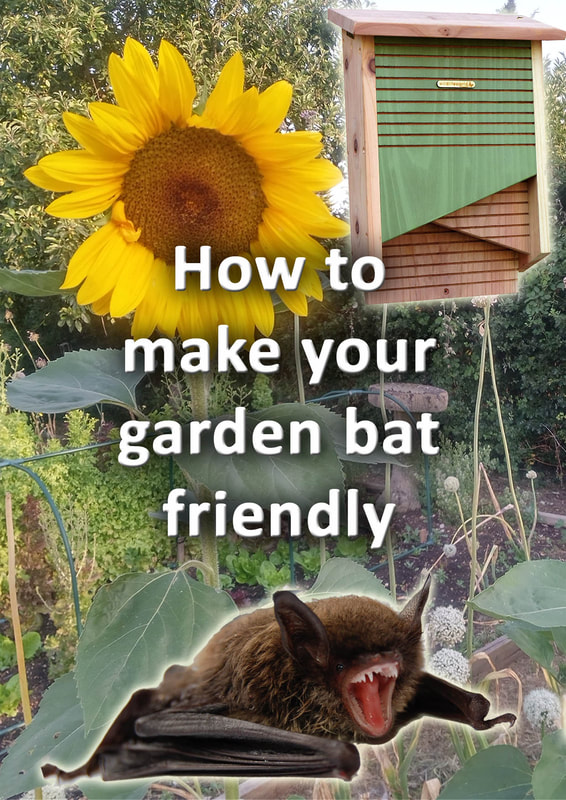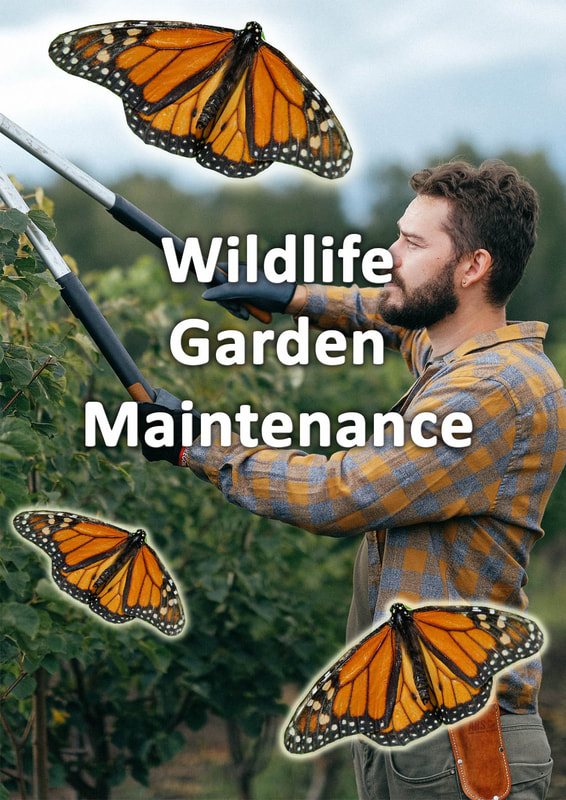|
This article contains affiliate links
Wildlife gardens are a great way to boost biodiversity around your home and bring you closer to nature.
If implemented correctly, wildlife garden ideas and proposals can be just as beautiful as traditional garden elements. Contrary to common believe wildlife gardens do not have to be an overgrown jungle. In fact, they can be integrated into any garden design style or theme. You may wish to dedicate only a small space to a specific habitat such as a wildflower meadow. Therefore, before planning or designing your wildlife garden it is a great idea to brainstorm. There are so many exciting, wildlife garden ideas which can bring your project alive! Below we have listed and described 32 interactive and exciting wildlife garden ideas for your project. From unique garden habitats to biodiversity, boosting, hobbies, we have it all here. 1. Viewing dens
Wildlife viewing dens are a fantastic way to set up intimate experiences with nature. Although most garden wildlife is accustomed to people, they still chose to keep their distance. This is especially so for the rarest wildlife. Viewing dens allow you to hide out within the landscape and patiently wait for wild encounters. Viewing hides are usually integrated within a greater wildlife garden design or strategy. For example, dens may be positioned looking over a wildlife pond or feeding area. Wildlife watching dens can even be constructed with recycled materials such as pallets or external grade timber. For extra effect they can be painted in camouflage or have a green roof installed on top. 2. Feeding stations
Feeding areas and stations can be particularly helpful during the winter months when natural food is scarce. This is particularly so for birds and endangered mammals such as hedgehogs. Such stations can be species focused and materialised as feeding platforms or feeders. It is very important however that you do not encourage vermin. All feeding operations should be restrained and monitored to make sure they are effective. It is also important that you do not over feed a particular garden visitor. This could make the subject lose its fear of humans and put it at risk of accidental harm. Feeding stations can be an effective way to support local wildlife but must be restrained and closely monitored. 3. Wildlife camerasWildlife cameras are a hi-tec way of seeing what animal species visit your garden, especially at night! The most popular choice today is the digital trail cameras. These can take image bursts and video clips if the built-in sensor detects movement. These exciting gadgets are reasonably priced and come in a wide range of specifications. Digital trail cams can be set up along trails or places of perceived wildlife activity such as ponds. The second type of wildlife cameras are live cameras wired into your TV port. These systems can allow you to tap nesting boxes or other areas of ecological interest. Wildlife cameras are a fantastic idea for anyone creating a wildlife garden. 4. Hibernacula’s
Hibernacula’s can take many forms but generally consist of a collection of both organic and recycled masonry materials. These are amassed randomly in a fashion which provides both shelter and nesting opportunities for wild creatures. One of the biggest threats to garden wildlife today is a lack of suitable nesting and shelter. Hibernacula’s can provide the perfect man-made habitat to mitigate the absence of shelter provided by naturally occurring habitats. 5. Bird boxes
Bird boxes come in a wide variety of shapes sizes and styles. Very often, boxes are designed with a specific species focus as certain birds prefer specific size entrances and nests. Many bird species also prefer to nest at varying heights and orientations to prevailing winds. This makes not only the box themselves important but also their installation. Bird boxes are a n effective way to encourage wild bird species to your garden. 6. Standing deadwoodStanding deadwood is a habitat niche which is utilised by specialised insects. In nature, standing dead trees would provide plentiful standing deadwood habitats for such species. In modern times, our obsession with clearing dead trees has led to a significant decline in specialised, standing deadwood species. A great wildlife garden idea is to incorporate standing deadwood into your project. Long tree trunks and branches can be set vertically into the ground. These can become pieces of ecological sculpture and be extremely, visually, effective and aesthetic. 7. Log pilesLog piles replicate dead wood habitats which would have once been common in historical landscapes. Piles of dead wood become places of food and shelter for many associated and specialised species. These would include fungi, bacteria, invertebrates and many species of insects. These decomposer species would contribute to the decomposition of deadwood into healthy topsoil. This directly facilitates healthy soil life which is the foundation for a vibrant ecosystem. Deadwood can also be amassed to provide shelter for other larger organisms such as reptiles, amphibians, mammals and birds. 8. Worm farms
Worm farming may not be the first thing you think when contemplating new wildlife garden ideas. However, wormeries are a great way to kick start a vibrant soil ecology. By amassing organic kitchen waste in a worm farm, you are increasing the number of worms in your garden. Worms are very important for aerating the soil and improving the soil's structure. This lays the foundation for more soil organisms and ecosystems to thrive. A wildlife garden with abundant soil ecology will always reach its maximum potential for wildlife. The more thriving organisms which exist at the base of the food web the more food there will be for species higher up. 9. Wildlife hedge
Wildlife hedges are a great idea for any wildlife garden. This is especially so for gardens with plain boundaries such as brick walls and fences. Garden wildlife hedges do not necessarily need to be huge hedgerows with large native species. They can be a mass planting of smaller garden shrubs beneficial to wildlife. The dense vegetation of wildlife hedges provides a great lattice of foliage which acts as great shelter for wildlife. You can also include shrub species which provide flowers rich in pollen and nectar as well as edible fruits! For more information on how to create wildlife hedge read our article on the subject here. 10. Raised bird baths
Water is essential for wild birds living in and around your wildlife garden. Not only is water important for them to drink but also to bathe. Bathing helps keep bird's feathers in top condition by removing particles of dust and dirt. However, bathing at ponds leaves birds vulnerable to ambush predators, especially cats. Consequently, it is a good idea to provide a bird bath which is high up off the ground. There are many raised bird baths on the market including some which can be mounted high up on walls. 11. Eco drainage
Eco drainage encompasses a range of sustainable strategies to harvest, recycle and reduce accelerated storm run-off. Water is often funnelled through and retained by natural wetlands or retention ponds. This helps to clean polluted water naturally and reduce flash flooding locally. Eco drainage allows water to be slowly reabsorbed by the soil instead of channelling it to drainage networks. The creation of such wetland habitats can be very beneficial to wildlife gardens. 12. Wildlife ponds
Wildlife ponds are one of the best installations for a wildlife garden. The fresh water allows numerous species of wildlife to drink, bathe and breed. Many species of insect actually need standing fresh water to complete their lifecycles. Many specialised creatures such as frogs and newts thrive in and around wildlife ponds. During spring they will mate and lay their eggs within vegetated shallows. Every wildlife garden should have a pond! Even if you can only install a small one it will go a long way to boosting local ecology. 13. Raised decks
Raised decks can be an effective way to provide some separation between people and wildlife. This is sometimes a necessary strategy to help wild species feel more secure. Raised decks can provide great viewing platforms over wild habitats. They can be designed to hover out over wildlife ponds to provide unique wildlife encounters. Raised decks also provide safe and sheltered areas under seating areas for numerous creatures to hibernate. 14. Wild meadows
Historically wild meadows were grown, cut and harvested to provide hay for the winter. This would be dry stored in outbuildings and feed to farm animals during the winter. However, with the development of modern agriculture these practices become redundant. This led to a dramatic population decline in wildlife flowers and the species which relied upon them. Wildflower meadows are a fantastic idea for a wildlife garden. Their blooms provide pollen and nectar will their vegetation offer shelter for invertebrates, insects, amphibians, reptiles and small mammals. 15. Fruit trees
Many assume fruit trees only benefit people in the garden. However, fruit trees also have many great advantages within the wildlife garden. Fruit trees flower early in the later winter and spring. This is to benefit from a long summer season so fruits can grow and ripen. This early source of nectar and pollen is a vital source of food for insects emerging from hibernation. This is especially so for bees who desperately need to feed after a long winter. 16. Wildlife only areas
Even though wildlife gardens should be good for people and wildlife it is important to develop 'wildlife only areas'. Most wildlife has an instinctive fear of people and for a good reason. Our noisy garden machines smash through vegetation killing anything in their path. Therefore, it is always a good idea to have some places where people do not go. This could be a small, overgrown corner of the garden or a gated pond area. These wild sanctuaries are also good places to focus wildlife watching dens upon. 17. Dry stone wallsDry stone walls can not only look very attractive they are also very rich habitat for wildlife gardens. Stonework can heat up in the morning sun providing warm microclimates which are favoured by many insects. Butterflies love to bask in the early morning sun warming up their bodies for flight. Small reptiles like the common lizard use these sites to raise their body temperatures after cool nights. The multiple cracks and crevices of dry-stone walls provide effective shelter for smaller creatures. You can even custom design your wall with small burrows and hollows for creatures to nest. 18. Bat boxes
Unfortunately, bats have seen dramatic declines in their populations across much of the developed world. A common reason for this is a dramatic reduction in the species they feed upon. This is mainly due to habitat loss and the agricultural use of insecticides. However, one of the challenges facing bats is a lack of suitable roosting sites. Bat boxes are a great way to mitigate the loss of naturally occurring roosting sites. The combination of bat boxes and rich habitats will make your wildlife garden a haven for endangered bat species. 19. Insect hotels
Insects are one of the largest wildlife and species categories in the world. There are literally billions of these small creatures which have colonised every continent of the planet. However, just because there are billions it does not mean they do not need help. Many species of insects can be very specialised. This means they may rely on a specific type of plant, soil type or habitat. With a dramatic reduction in wild habitats over the past century many insect numbers are falling. Insect hotels can provide plenty of safe places for insects to seek shelter and hibernate. This makes them an effective wildlife garden idea! There are plenty of great looking designs on the market or, if you feel creative, you can build your own! 20. Solitary bee hives
Another great wildlife garden idea is asolitary beehive. These hives typically take the form of a timber nesting box with a series of tubular like holes. Many of our most important pollinating bees are not a part of large colonies but solitary. These solitary bees' nest, hibernate and lay eggs in narrow holes where they can remain safe and secure. Some create a series of chambers containing a single egg with enough food for when they hatch. You can keep inspecting your solitary bee hotel to see if a mother bee has sealed of the openings with leaves or mud. We have linked to a good example of an effective solitary beehive here. 21. Create access
A major challenge for larger garden wildlife is having free access to roam around. Residential gardens are encased by sealed boundaries and fences which can act as an impenetrable boundary. One of the ways you can mitigate this is by creating an access hole. This can be created in timber fences with a jig saw or a circular stone cutter for masonry. Alternatively, you can excavate a miniature underpass for garden wildlife. Try to make you will cause no damage to your neighbour's boundary or garden. Try to position your access route in a position which has adequate cover on both sides. 22. Green roofs
Green roofs are an effective way to boost the habitat potential of roofs or other flat surfaces. These can be installed to log stores, sheds, garages or other garden structures. Many believe that green roofs are complicated set ups with specialist irrigation systems. However this could not be further than the truth. The most basic green roofs are sedum roofs which have very shall build ups of free draining, soil, aggregates. All you will need is a weed barrier, membrane, tray system, aggregate and the sedum itself. This can come as sedum mats or cuttings which are scattered across the surface. 23. Grow climbers
Climbing plants are very beneficial for wildlife gardens, especially those which provide fruits and nectar. Climbers allow you to cover otherwise bland and lifeless vertical boundaries with vegetation. This can help to regulate a gardens temperature and provide ample shelter for wildlife. Climbing plants can also be grown over structures and even standing deadwood habitats. For a list of climbers that are great for wildlife visit ourbest plants for wildlife article here. 24. Build a compost heap
Compost heaps can not only help you to recycle organic waste they can also compliment wildlife gardens. Allowing garden waste to break down naturally helps to feed microorganisms within the soil. This process helps to invigorate soil ecosystems and provides a rich diversity at the base of the food chain. Consequently, gardens with vibrant soil ecology have more abundant wildlife species as a whole. Compost heaps also provide moist and warm places for numerous species to hibernate and seek shelter. This is particularly so for reptiles and amphibians who are cold blooded. You can organise your compost heap with more entry points to encourage more nesting opportunities. 25. Start bee keepingWhat better way to encourage more bees into your garden than by becoming a beekeeper. Not only will you be helping to increase the number of pollinators you could produce your own, fresh honey. Becoming a beekeeper is a gradual process of learning and experience. It is advised to get involved with our local bee keeping group or association. From there you will learn from experienced keepers and then obtain your first swarm. If you are interested in keeping your own bees it will be informative to obtain a book on the subject. Bee keeping is one of the most productive and exciting wildlife garden ideas. 26. Grow edible plants
Choosing to grow edible plants can be an interesting but effective idea for wildlife gardens. Typically, if a plant is edible for us, it usually is also edible for wildlife. There are plenty of examples of culinary plants which can also attract wildlife. The foliage and flowers of many kitchen herbs are a magnet for beneficial insects and pollinators. Fruit trees provide both early flowers and autumn fruit for numerous wild species. There are also a whole range of other, less well-known edible plants great for wildlife gardens. For a full list of examples visit our article on how to create an edible garden here. 27. Hammocks
Hammocks may not be the first idea that comes to mind for a wildlife garden. However, the importance of sitting back and enjoying your project cannot be underestimated. The longer you relax comfortably in your garden the more wildlife you will encounter and enjoy. By spending time lounging around in your garden the more local wildlife will get used to your presence. Hammocks can provide the most comfortable way to relax within nature. Sit back, read a book, or just close your eyes and saturate your soul in the sounds of nature! 28. Provide nesting materials
During the early spring many wildlife species, especially birds are searching for soft and warm nesting materials. These cannot always be found readily available within the landscape. By providing nesting materials within your wildlife garden, it can great help wildlife to build nests. One thing you can do is grow plants that provide natural nesting materials. These can be fluffy seeds or thin and hay like stems and foliage. These can include ornamental grasses, Cottonwood trees, Wild Clematis, Birch, Pampas grass, Cardoons, ferns and mosses. Alternatively, you can provide natural fibres such as cotton, wool, hair and hemp. Many retailers now sell natural nesting materials such as Alpaca wool in a hanging cage. 29. Herb gardens
Herb gardens are a great idea if you love to connect the garden to the kitchen. Fresh herbs are fantastic for all manners of cooking activities and even making your own herbal teas. However, herb gardens can also be a great idea for wildlife gardens. Many beneficial species of insects including ladybirds, hoverflies, parasitic wasps and solitary bees are attracted to herbs. This is especially so with the flowers of, Mint, Oregano, Fennel, Thyme, Dill, Sage and Parsley. Herb gardens can also form a dense groundcover of vegetation which provides ample shelter for multiple wildlife species. 30. Create suntraps
Garden wildlife is not too different from us and prefers warm, sunny, conditions than cold. Many species like to bask in the early morning sun to warm up after a cold night. A great wildlife garden idea is to create suntraps by manipulating microclimate. This can be achieved by modifying areas which receive sun to warm up. Perhaps you could build a dry-stone wall with light coloured stone with plenty of cracks and crevices. Not only will the light colours reflect sunlight the masonry will warm up and release warmth slowly. Gravel paths and surfaces are another material which can help boost microclimate. 31. Grow wildflowers
Wildflowers are wild plants which are found in a natural habitat type or region. Very often, a specific species will be specialised to a particular soil type or niche. This means it is very likely specialised, wildlife, species will be attracted to them. Wildflowers are one of the main indicators of a diverse and vibrant habitat. Find out what wildflowers are native to your specific region and conditions. There are now many wildflower seed suppliers online with specialised seed mixes for various conditions. 32. Man made burrowsAn interesting way to give your wildlife garden a boost is to build man made burrows. These simple installations involve building safe places for wildlife to hibernate and raise young. How you build your burrow will depend on what species you are trying to encourage. Find out what the maximum size of the species is to provide an appropriately sized entrance hole. If you want to encourage common lizards perhaps create a sandy hollow built into a dry-stone wall. For hedgehogs you could build a nesting box out of bricks submerged under a small meadow mound. Our wildlife garden servicesBuckinghamshire landscape gardeners are experts in wildlife garden design and construction. Acting as the domestic landscaping part of Ecospaces we have over 20 years' experience in ecological landscaping and sustainable construction. If you are interested in our wildlife garden services, please do not hesitate to contact us. Our wildlife garden services include:
Thank you for reading our article on 32 exciting wildlife garden ideas! Why don’t you help us spread the message about wildlife gardening by sharing this post? Below we have also included some of our other wildlife garden articles you may find useful.
'As an Amazon associate I earn from qualifying purchases'
0 Comments
Leave a Reply. |
The Author
|
Landscaping services across Buckinghamshire, Amersham, Aylesbury & High Wycombe
Hyde Heath, Amersham, Buckinghamshire |
|





























































